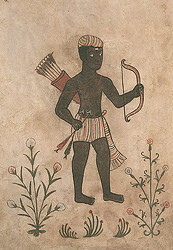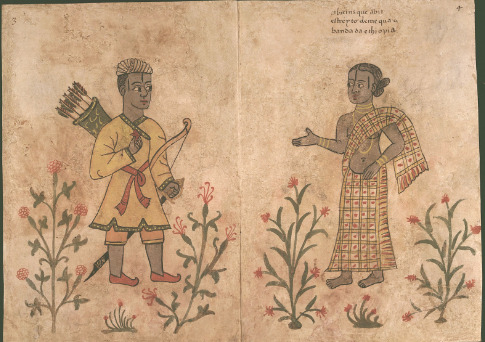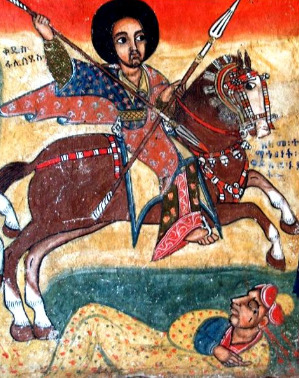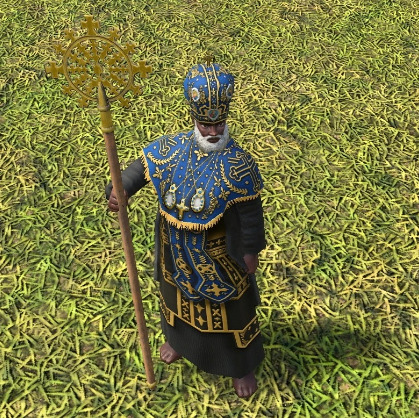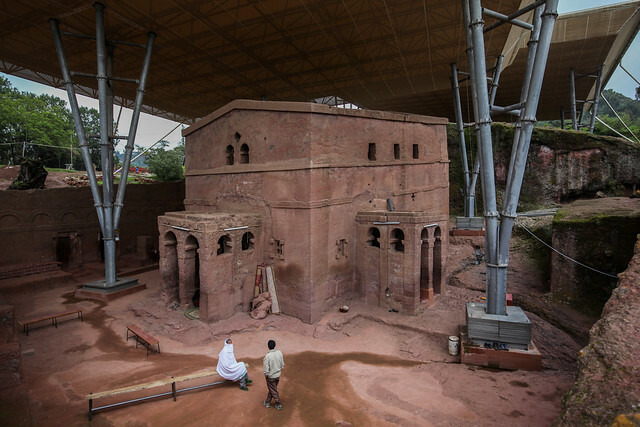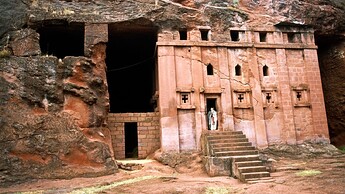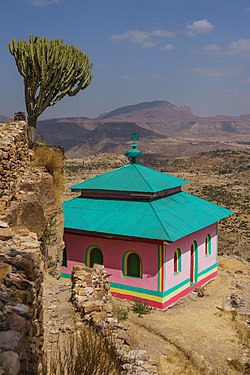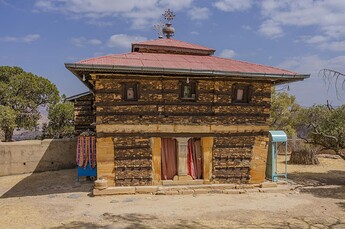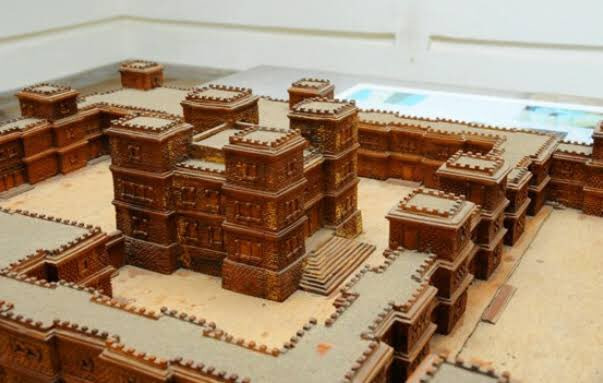The Ethiopians
Churches, Bartering, Skirmishing
7th Century to mid-16th Century
Difficulty: 3/3
Hi everyone, welcome to my third civ concept. Sorry I’m missing one of Seicing’s fancy AoE4 style flags for this one. I always think I’ll never do another one because of how much work they are but I always seem to find some new interesting concept to explore. This one went a little differently than I expected. In the course of my research, I also learned about the neighboring Medieval Nubian Kingdoms of Makuria, Nobadia, and Alodia, and realized there were a lot of really cool aspects about them that I really wanted to explore in a civ design. You could very well argue that they deserve a separate civ, but based on likelihood we would only ever get one civ from this region, I decided to combine references to these kingdoms, especially Makuria, into my Ethiopian civ design because they all deserve representation. I fully understand they were different peoples with different languages and cultures, but their shared Religion and remarkably consistent peaceful coexistence make it within the realm of plausibility that they could work together. For the civ name I settled on Ethiopians just because of the name recognition, lasting legacy, and more accessible language. As always, every unit, bonus, and unique feature has some basis in history that I have researched to the absolute best of my ability, and once again, there are no numbers on the bonuses because without balance testing numbers are useless. Feel free to ask ‘why did you do this’ for anything you see!
Background and Inspiration
A Cradle of History : Very few, if any places on Earth have as much human history as Ethiopia and the Horn of Africa. Not only is Ethiopia one of the oldest countries in the world, but there is speculation that the very first humans originated from here. Contemporary Ethiopia has its roots in the Aksumite Kingdom, which in the third century AD was described as one of the four great empires on Earth, along with Rome, Persia, and China. After the decline of the kingdom of Axum, the region entered a ‘dark’ age about which not much is known. Legends abound about a mysterious, usurping, warrior queen known as Gudit who laid waste to the land, and was eventually supplanted by the Zagwe dynasty. Finally, the ‘Solomonic’ Dynasty that claimed descent from the original rulers of Axum and the biblical King Solomon regained power and led Ethiopia all the way up to the late 20th century, remaining one of the only African countries never fully colonized by an outside power.
An Island of Christianity: Although most people associate it more with Europe, Christianity took very strong root among the Kingdom of Axum and the neighboring Nubian kingdoms, with both regions falling under the Coptic Orthodox Patriarchate in Alexandria. After the Arab conquests, these Christian kingdoms became isolated from the rest of the Christian world, but fiercely persisted. Makuria established itself as a front to the expansion of the Arab caliphates, famously defeating the Rashiduns twice and resulting in the ‘Baqt’, a nearly 700-year peace treaty, while Ethiopia clashed with the sultanates of the South/East African coast. They built many churches, including the incredible monolithic Lalibela Rock Churches, and every Ethiopian Church is consecrated by the storage of a Tabot, a replica of the ten commandments. This devotion resulted in the legend of a mythical ‘Prester John’ spreading among Europeans, said to be the leader of a powerful, isolated Christian nation that would eventually bring victory in the Crusades. This legend was one of the motivations of the Portuguese expeditions around Africa.
Empires of the Nile: After the fall of the Aksumite empire and the cessation of minting of coins, Ethiopia was unique in having had a barter-based economy lasting well into the post-medieval age, while the Nubians cultivated the banks of the Nile into a bountiful region. Ethiopia was defended by regiments of Chewa, the Ethiopian equivalent of a Feudal Lord/Knight. Soldiers used javelins and spears extensively, and the Ethiopians are also well known for their unique, sickle-like Shotel sword, which was used up into the modern period to various ceremonial and military degrees. Armor was known and used, but sparingly. In the neighboring Nubian kingdoms, it was their ‘pupil-smiter’ archers that were universally renowned for their skill and accuracy and kept the caliphates at bay.
Civilization Design and Concept
Concept: The tides of the Ethiopian civilization fall nicely within the timeframe of the game, with the Dark age aptly corresponding to the Ethiopian ‘Dark Age’ in a weakened post-Aksumite Empire, the Feudal age representing regrowth through the Zagwe dynasty, and the Castle and Imperial ages representing the expansion under the Solomonic Dynasty. Similar to Mali, Ethiopian units lack bulk initially and rely on hit and run tactics. Their lack of gold units and market based influence bonus reflect their barter economy. With relatively weaker units and no strong early eco bonus, players will have to use unique strategies such as the ‘Baqt’ treaty or new AoE ‘Wololo’ abilities to hold off enemy armies while building up their Church-oriented bonuses and aging up in a unique way. Their navy is nothing special but they have the ability to maintain a strong shoreline eco without needing total water control.
Language: In Dark age, the units should speak the original language of the Aksumite Empire: Ge’ez, which is still used today as a liturgical language (similar to Latin). In the Feudal age and beyond, they should speak Amharic. Other languages that could be used include Tigrinya and Nubian (for the archer unique unit especially)
Architecture: I’ve reserved the post below this for screenshots of architecture
Bonuses
-
Ethiopian units and technologies don’t cost gold, except for age-ups and Religious units and technologies (the food/wood cost, most likely of siege units, could be adjusted for balance).
-
Ethiopians cannot kill and gather from Boar (Ethiopian Orthodoxy follows Jewish Kosher diet)
-
Villagers drop off extra food at docks and saqiyas.
-
Ehiopians can enter into a ‘Baqt’ with any other player. At any point (with a cooldown), you can tribute that player gold to stop all combat for yourself and that player (including with other players in Team games). During this period, towers and keeps cannot be built outside of a radius around the TC. The gold cost could start off small and scale up the more you use it.
-
While mining stone and gold, a Monolith Church is automatically built on top of the mine as it depletes (will complete before mine is exhausted). This building is a combination of a landmark and a monastery and provides bonuses.
-
The Ethiopian Abuna unit can build and carry a Tabot. A Tabot cannot be built if there is no Church in which to store it. It has various AoE effects (see unique unit section) and must be placed in a Church or monastery to enable ability cool-down.
-
Ethiopians age up by researching one of two religious-themed technologies at a Monolith Church with a Tabot which only costs gold. Once researched, that church becomes a landmark.
Influence:
- Markets are available in the dark age and extend influence. All drop off buildings within influence can be tasked to automatically trade the resource for any other resource at barter rates (similar to trading resources through the market, but instead done automatically). Just like at a regular market, the rates get worse over time so you can’t just task all vills on one resource and forget. One goal is to differentiate the initial build order by encouraging sending the majority of villagers to gold or stone and use the influence bonus to trade for food, while building the initial Monolith church ASAP.
Unique Features
Buildings
-
Saqiya (I): Ethiopian mills can be placed on water like a dock. In this case, they become Saqiyas and result in more food drop off.
-
Farms (I): Ethiopian farms should uniquely grow Teff.
-
Monolith Church (I): Built automatically on top of mines. Monolith Churches have unique names and can only be attacked by siege units. Villagers and monks can garrison inside of Monolith churches (but they gain no attack). Each Monolith Church built increases HP of all units and improves barter rates
Unit Roster
Unique Units
-
Abuna (I, Town Center): A unique religious unit present at the start of the game. Only one can exist at a time. If it dies, a new one is spawned automatically from the town center. The unit can perform all the regular functions of a monk and also build and carry Tabots to perform special activatable abilities. Beyond age 3, these abilities can also be activated with a standard relic.
******* AoE Conversion: Same as with a regular relic, but available in dark age
******* AoE Heal: Rapidly heals all units within radius
******* AoE Celebration: All villagers in radius gain increased HP, attack, and movement speed. -
Archer of the Eyes (II, Archery Range): A ‘glass-cannon’ archer with low HP and higher attack. Has two activatable abilities: one to debuff attack speed of any units it hits, the other to debuff movement speed. Very weak vs AoE damage and units that get up close.
-
Chewa (III, Barracks) : A less bulky man-at-arms that can throw a high damage javelin at short-to-medium range on a cooldown and also carries a Shotel for a small attack bonus vs cavalry (since one of the theoretical uses of Shotels was to hook people off horses).
-
Takula Rider (II, Stable) : A horseman unit that can throw a short-range javelin on cooldown. Strong charge attack but less HP and/or armor than horsemen.
-
Alodian Lancer (III Stable): Cheaper Lancer unit that starts off with less armor and attack than a standard one (similar to a Sofa), but gets increased armor and/or attack based on the number of Relics and Sacred Sites taken (up to a maximum)
Ships: Dhow, War Dhow, Explosive Dhow, Carrack.
Missing from Standard Roster: Archer, Horseman, Man-at-arms, Lancer/Knight, Ribauldequin, Culverin
Technologies
-
Coffee Cultivation (II, Mill): All units gain slightly increased speed and training time
-
Master Stonecutters (III, Mining Camp): Monolith Church HP increased. Gold and stone mining speed (and hence Monolith build time) increased.
-
Chewa Garrisons (III, Barracks): Chewas garrisoned in outposts for a certain length of time gain increased attack speed for a period of time after ungarrisoning.
-
Sarawit (IV, Barracks): Melee infantry gain bonus damage vs siege weapons
-
Treaty Provisions (II, Church/Monastery): Baqt provides a small trickle of food and wood
-
Aggressive Negotiations (III, Church/Monastery): Military production speed and villager build speed greatly increased during Baqt
-
Fasting Rites (IV, Church): All units cost less food
-
Katamas (III, Keep): Destroyed buildings and palisade walls refund all of their wood cost (even if deleted)
-
Sewn Boats (II, Dock): Villager repair speed on boats increased and costs fewer resources
-
Shoreline Defenses (II, Dock): Docks can garrison more fishing ships. Towers and dock emplacements gain increased bonus damage vs ships.
Age-Up Technologies
Feudal: Defensive buff vs Economic buff
-
Ark of the Covenant
- Monolith Churches provide increased armor to all units in radius
-
Illuminated Manuscripts
- Monks garrisoned inside Monolith Churches gather gold and stone from remaining mine
Castle: Micro-focused, high-risk, high-reward bonus vs ‘standard’ lower risk eco bonus
-
Spiritual Wall Paintings
- Monolith churches provide increased gather rates in radius (do not stack)
-
Kebra Nagast
- Monks can now carry Tabots and use abilities. Abunas can use abilities twice before requiring a cooldown.
Imperial: Military Flexibility vs Increased Economy
-
Holy Pilgrimage
- Monks can ‘pilgrimage’ (trade) between Monolith Churches and neutral or allied markets. While on pilgrimage, they gain a small AoE heal and gather rate boost. The trade rate can be nerfed to compensate.
-
The Legend of Prester John
- Monolith Churches can produce Elite Royal Knights, Portuguese Arquebusiers, Elite Landsknechts or Culverins (cost could be adjusted for balance). Carrack cost decreased at docks.
Wonder
-
Covenant Church
(Based on the Church of Our Lady Mary of Zion, where the Ark of the Covenant is claimed to be kept (even though we all know it’s in a secret vault being looked after by ‘top men’).

